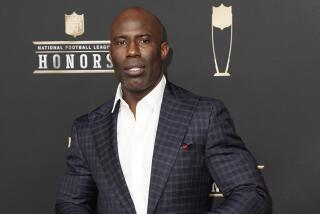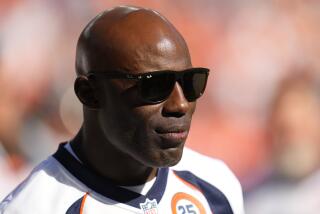Column: At United Airlines and Wells Fargo, toxic corporate culture starts with the CEO

Here’s United Airlines’ latest PR nightmare. (April 11, 2017)
The airline and banking industries may seem to be about as different as chalk and cheese, but United Airlines and Wells Fargo have been shown to share a common bond: toxic corporate cultures that can be blamed on the men at the top, their chief executives.
Wells Fargo’s John Stumpf is gone, having resigned last October in the aftermath of the bank’s fraudulent account scandal. United’s Oscar Munoz only took office in September 2015. This week’s crisis over the airline’s violent deplaning of passenger David Dao to make room for a traveling crewmember was a major test of his leadership, and he flunked. Munoz’s response to the incident, like Stumpf’s tolerance of the misbehavior of one of his top lieutenants and her employees, threaten to make things immeasurably worse for his company’s customers. For a CEO, that’s a cardinal sin.
What these companies have in common is the status of the employees at the center of their crises: It’s low. Patrick Smith, the air travel expert who helms the Ask the Pilot website, attributes the United incident to the gate staff’s “lack of empowerment.” That term also could describe the beleaguered Wells Fargo salespersons who opened thousands of fake accounts in customers’ names to meet crushing sales quotas.
I also emphatically stand behind all of you, and I want to commend you for continuing to go above and beyond to ensure we fly right.
— United Airlines CEO Oscar Munoz, congratulating his workers for an incident that resulted in a passenger’s injury
The relentless pressure on low-level bank employees to open multiple accounts per customer came from the head of the retail bank division, Carrie Tolstedt, who reported directly to Stumpf. Tolstedt was known as an inflexible hard-charger who guarded her division’s prerogatives jealously, even forbidding her own subordinates to provide sales information to top corporate officers.
As Stumpf probably knew, Tolstedt’s management was a torment for her employees. Turnover in her division reached at least 30% every month from 2011 through 2015, and 41% through most of 2012. In the Los Angeles region and others, managers applied “extreme pressure, … calling their subordinates several times a day to check in on sales performance and chastising those who failed to meet sales objectives,” according to an internal investigation of the scandal released Monday.
The salespersons met the very definition of powerlessness; failure to meet quotas meant dismissal, and there was no path for complaints or respite from the demands. The numbers were everything, and no one looked too closely at how they were reached.
That attitude came directly from the corporate suite. To Stumpf, Tolstedt’s flaws where outweighed by the profits her division was producing. The report states that Stumpf acknowledged to the board of directors “problems with Tolstedt’s leadership style, including that she was controlling, but also praised her as ‘the best banker in America.’” When the board tried to clip her compensation, Stumpf fought back, and won.
As a relative newcomer to United, Munoz has had a different impact on the corporate culture. A longtime board member at Continental Airlines who stayed on when it merged with United in 2010, Munoz was thrust into the CEO’s job in 2015 to replace Jeff Smisek, who resigned in connection with a federal investigation into corporate graft. With management stints at Pepsico, Coca-Cola, AT&T and the railroad company CSX, Munoz had never run a service company such as an airline, whose workforce deals directly with paying customers.
Munoz began his tenure by making friends with United’s unhappy workforce. Just a month ago, he was named “U.S. Communicator of the Year” by PR Week magazine, largely for his success in reaching out to “the airline’s pilots, flight attendants, mechanics, and other workers.”
Yet in the wake of Sunday afternoon’s incident at O’Hare Airport in Chicago, Munoz failed for two days to reach out to the traveling public. At O’Hare, gate staff informed passengers already seated on the Louisville-bound aircraft that four would have to give up their seats to make room for a crew due at the destination. When none accepted the airline’s offer of $800, overnight accommodations, and a flight nearly 24 hours later, the staff selected four passengers by computer. Dao, a 69-year-old physician, refused to give up his seat. Instead, airport police forcibly removed Dao from his seat and dragged his bloodied body down the aisle.
In two statements Monday, including an internal letter to employees, Munoz chose to see the incident entirely from the workers’ point of view. He depicted the airline staff as having treated Dao “politely” and “apologetically” and Dao as “disruptive and belligerent.” He said the airline agents “were left with no choice but to call Chicago Aviation Security Officers to assist in removing the customer from the flight.”
He added, “While I deeply regret this situation arose, I also emphatically stand behind all of you …. Treating our customers and each other with respect and dignity is at the core of who we are.”
In a third statement issued Tuesday, Munoz finally made the right noises. “I deeply apologize to the customer forcibly removed and to all the customers aboard, he said. “No one should ever be mistreated this way.”
He pledged to “work to make it right” via a “thorough review” of passenger bumping policies as well as United’s relationship with local law enforcement agencies, with a public report due by April 30.
The available videos of Sunday’s events don’t depict the prelude to the arrival of airport police on board. And the Vietnam-trained Dao has had a checkered disciplinary history with Kentucky medical regulators. But there’s been no indication that he behaved improperly before the United staff demanded his seat. And judging from the infuriated public reaction, removing already-seated passengers from a flight to make room for airline employees plainly strikes travelers as irregular and improper.
Munoz’s initial failure to consider the passengers’ point of view bodes ill for United’s customer relations in the future unless his approach changes dramatically. His knee-jerk support of United’s staff threatened to encourage intransigence among employees at the gate and on board in dealing with problems. This has been a long-standing issue with United.
According to federal statistics, for example, the airline is in the middle of the pack among U.S. airlines for involuntary bumping — at about .45 per 10,000 passengers in 2016.
But its number of consumer complaints for bumping and other issues has been consistently among the highest of U.S. carriers: In January, United passengers lodged 174 complaints with federal authorities, compared with only 87 against Southwest, even though Southwest on average carries nearly twice as many passengers.
The difference may lie with employee attitudes and their latitude to manage the myriad problems that crop up at the airport and on board.
Munoz’s reaction also glossed over what may be real constraints on United employees’ ability to manage workaday glitches. At the United gate in Chicago, Smith conjectures, “the airline’s staff reached a point, after perhaps offering whatever dollar amounts their procedures called for, where they simply didn’t know what to do, and nobody was brave enough, or resourceful enough, to come up with something. Summoning the police simply became the easiest way to pass the buck.”
That’s typical of the culture of big airlines, Smith adds. “Everything is scripted and rote and procedural. …. Workers are deterred from thinking creatively exactly when they need to.”
While the full details of Sunday’s incident still aren’t known, solutions to the problem of getting a four-person crew to Louisville short of ejecting paying passengers are obvious: the airline could have had them driven to their destination, a trip of less than five hours; or it could have chartered a plane for them; or United could have offered more than $800 to find passengers willing to give up their seats.
But that would have required empowering the employees on the ground.
Munoz’s response doesn’t achieve that. He hasn’t given a concrete indication of plans to change United’s culture to encourage creative thinking on the ground. If United’s culture doesn’t change, he’ll have to take the blame, like John Stumpf.
Keep up to date with Michael Hiltzik. Follow @hiltzikm on Twitter, see his Facebook page, or email michael.hiltzik@latimes.com.
Return to Michael Hiltzik’s blog.
ALSO
United’s CEO turns contrite as fallout spreads from passenger mistreatment
David Dao, United passenger who was dragged from plane, says he’s still in the hospital
United passenger threatened with handcuffs to make room for ‘higher-priority’ traveler
UPDATES:
3:18 p.m.: This post has been updated with United CEO Oscar Munoz’s statement of apology for Sunday’s incident.
More to Read
Inside the business of entertainment
The Wide Shot brings you news, analysis and insights on everything from streaming wars to production — and what it all means for the future.
You may occasionally receive promotional content from the Los Angeles Times.











